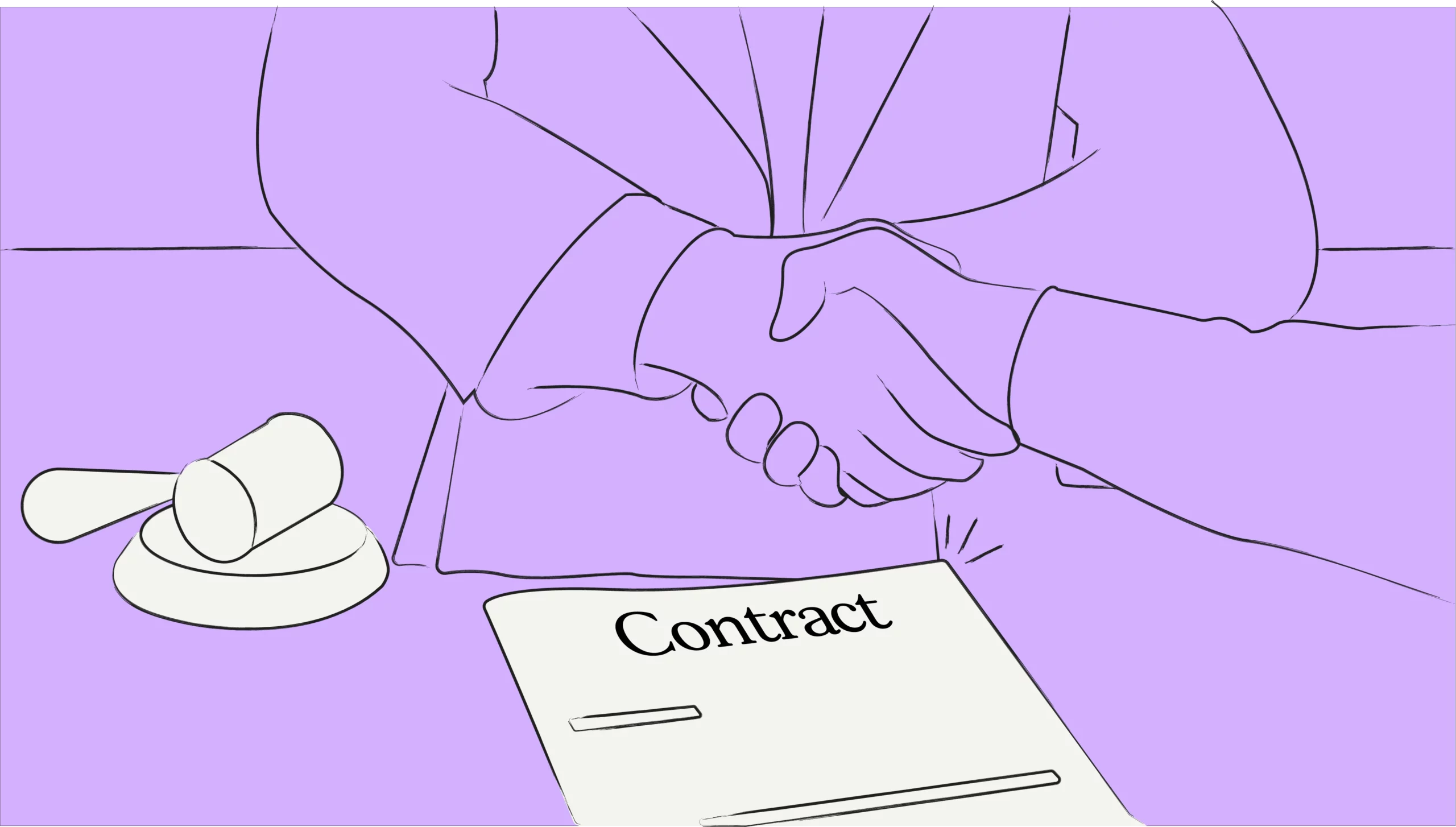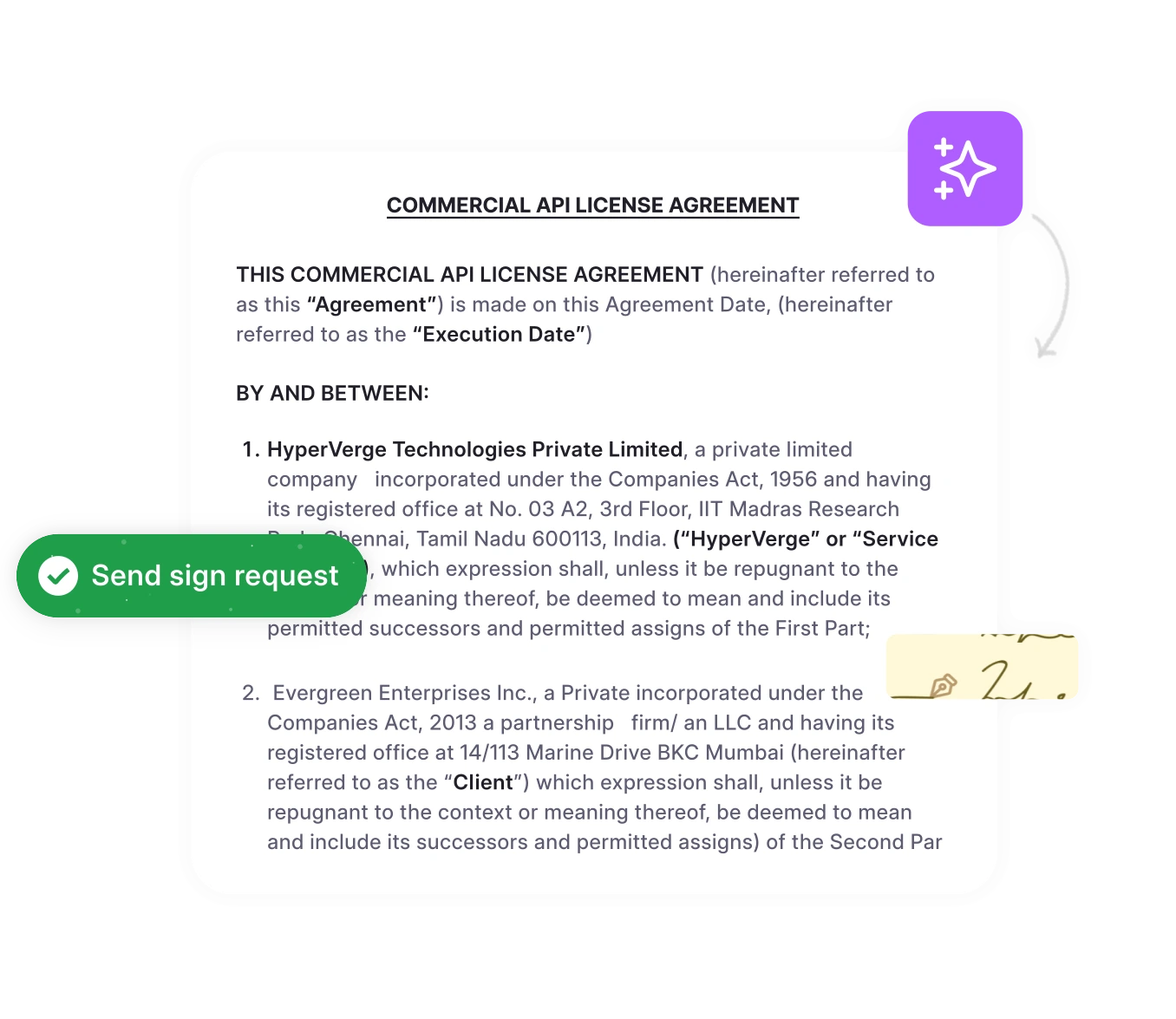Payment disputes over unclear deliverables. Legal complications from ambiguous scope definitions. Confidential information is at risk without documented protections. These scenarios represent common pitfalls in consulting relationships that lack properly structured consultancy agreements.
Whether you need a simple consulting contract template for a quick project or a comprehensive consulting agreement example for complex engagements, understanding essential components protects both parties and sets clear expectations. This guide covers everything you need to know about consulting agreement components, from scope definition to termination clauses, helping both contract consultants and clients enter relationships with confidence.
What is a consultancy agreement? [Definition]
A consultancy agreement is a legally binding contract between a client and a consultant that outlines the terms and conditions for services provided as an independent contractor.
This agreement:
- Establishes that the consultant is not an employee of the client.
- Outlines the scope of work, including deliverables and timelines.
- Specifies the payment terms, such as fees, milestones, and expenses.
The primary purpose of a consultancy agreement is to protect both parties by creating a clear record of expectations, responsibilities, and deliverables.
Whether you’re drafting a business consulting contract or a freelance consultant contract template, the core components remain consistent. A service agreement may also be used interchangeably, though consulting agreements often involve higher-level strategic work.
Ready to eliminate contract chaos?
Modern contract management platforms automate consultancy agreement workflows from creation to renewal tracking across all contract types.
Book a DemoKey Clauses and Provisions in a Consultancy Agreement
Let’s look at the key clauses that form the foundation of a strong consultancy agreement — from defining the scope of work to managing confidentiality and ownership rights.
1. The scope of services and deliverables in a consultancy agreement
The scope section forms the foundation of any consultancy agreement. It defines what work the consultant will perform, what the final deliverables will look like, and—just as importantly—what’s not included.
Without a well-defined scope, you risk scope creep, missed expectations, and payment disputes later in the project.
Start with a detailed description of services. Avoid vague terms like “marketing services.” Instead, specify whether the consultant will handle market research, campaign strategy, content creation, or performance analytics. The more specific your scope, the less room there is for misunderstandings.
A marketing consulting agreement should outline whether deliverables include campaign design or execution, while a financial consulting contract might define whether the consultant provides only analysis and recommendations or also implements changes.
According to the Government of Singapore’s Building and Construction Authority, a clear specification of deliverables is crucial in consultancy agreements to avoid ambiguity and disputes. Their Standard Consultancy Agreement (September 2024) warns that incomplete or vague scope definitions are a leading cause of project disputes and additional expenses, emphasizing the need for detailed, written deliverables in the contract.
A statement of work typically accompanies consulting contracts to provide more detailed information on deliverables, acceptance criteria, and dependencies.
What to include in your scope definition:
- Specific tasks and activities the consultant will perform
- Concrete deliverables with formats and specifications
- Dependencies or client responsibilities required for completion
- Explicit exclusions to prevent scope expansion
- Review and approval processes for deliverables
- Resources or access that the consultant needs from the client
Always tie deliverables to your project milestones. This creates natural checkpoints where both parties can assess progress and ensure alignment before moving forward.
2. Project timeline and milestones
- How will we evaluate whether the consultant is meeting expectations?
- What specific metrics, quality standards, or completion benchmarks will be used?
Setting clear timelines is essential to avoid one of the most common causes of breakdown in consulting relationships — misaligned expectations about when work should be completed.
Your consultancy agreement should not only specify the start and end dates but also break the engagement into manageable milestones.
Milestone-based structures work exceptionally well for consulting projects because they let both parties review progress before significant resources are invested.
For example, a three-month strategic consulting project might be structured as follows:
- Month 1: Discovery and analysis
- Month 2: Strategy development
- Month 3: Implementation roadmap
Each milestone should have defined deliverables and acceptance criteria. This clarity helps avoid situations where a consultant believes they’ve completed a phase, but the client expects something entirely different.
The contract duration should account for realistic timelines, including review periods and potential revisions.
Performance Measurement Criteria
This section should also specify how performance will be measured. Define metrics and benchmarks before work begins — not after problems arise.
Ask questions like:
Setting these expectations up front makes the agreement measurable and fair for both parties.
Read How to Write a Contract: Complete Guide for Legal Teams
Types of consultancy agreement timeline structures
| Timeline Structure | Best For | Key Advantage | Potential Drawback |
| Fixed duration | Defined projects with clear endpoints | Budget certainty and planning | Less flexibility for scope changes |
| Milestone-based | Complex multi-phase engagements | Progress checkpoints and payment alignment | Requires detailed upfront planning |
| Rolling/ongoing | Advisory relationships without fixed end dates | Flexibility and long-term partnerships | Can lack urgency or clear deliverables |
The structure you choose depends on the nature of the consulting engagement, but milestone-based approaches generally offer the best balance of flexibility and accountability.
3. Compensation and payment terms
Getting paid correctly — and on time — starts with clear payment terms in your consultancy agreement. This section should leave no ambiguity about how much will be paid, when payments are due, and what happens if they’re late.
For consultants managing multiple clients, standardized payment terms also help reduce administrative overhead and prevent confusion.
Fee Structure Options
Consulting agreements can adopt several different fee models, each suited to different types of work:
- Hourly rate: Ideal for ongoing or advisory work where time commitment is unpredictable.
- Fixed price: Best for projects with a clearly defined scope and deliverables.
- Retainer: Ensures ongoing consultant availability and support, typically billed monthly.
- Performance-based: Links compensation directly to outcomes or results achieved, though this adds complexity around measurement and risk-sharing.
A time and materials contract charges for actual hours worked plus expenses, offering maximum flexibility but less cost predictability. Fixed-price contracts provide budget certainty but require obvious scope definition to avoid disputes when additional work is requested.
Payment schedules should mirror your project milestones.
For example, you could structure payments as:
- 30% upfront to initiate the project,
- 40% at the mid-project milestone, and
- 30% upon completion.
This structure protects both sides — giving the consultant sufficient working capital while ensuring the client retains leverage until final delivery.
Common Fee Structures in Consultancy Agreements
| Fee Structure | When to Use | Consultant Advantage | Client Advantage |
| Hourly rate | Unpredictable time requirements or ongoing advisory | Paid for all the time invested | Only pay for actual work performed |
| Fixed price | Well-defined deliverables and scope | Revenue certainty for efficient work | Budget predictability and no surprises |
| Retainer | Ongoing access and support needed | Predictable monthly revenue | Guaranteed consultant availability |
| Performance-based | Results-driven engagements with measurable outcomes | Higher potential earnings for strong results | Payment tied directly to value delivered |
Expense policies should be clearly defined. Specify whether the consultant can bill for:
- Travel and accommodation
- Software subscriptions or tools
- Research materials or data sources
Set reimbursement limits and require receipts or pre-approval for expenses over a certain amount. This prevents unpleasant surprises or delayed disputes months after project completion.
Address tax responsibilities explicitly. As independent contractors, consultants are typically responsible for their own tax filings and withholdings.
Your consultancy agreement should clearly state that:
- The client will not withhold taxes on payments.
- The consultant will receive a 1099 form (in the U.S.) rather than a W-2.
Protect yourself from late payments by including:
- Interest rates on overdue invoices (e.g., 1.5% per month or the maximum legal rate).
- The consultant has the right to pause work if payment is delayed more than 30 days.
For ongoing relationships, define renewal and extension terms — such as automatic renewal options or required notice periods for termination.
A master services agreement can provide an umbrella framework with individual statements of work for each project, streamlining the contracting process for repeat engagements.
Understanding consideration in contracts ensures that your payment terms create legally enforceable obligations. Both parties must exchange something of value for the contract to be binding.
Managing multiple consultant agreements?
AI-powered contract management eliminates manual tracking with automated workflows, centralized storage, and intelligent renewal alerts for all your consulting contracts.
Book a Demo4. Confidentiality and non-disclosure provisions
Consultants frequently access sensitive business information, including financial data, strategic plans, customer lists, proprietary processes, and trade secrets. Without confidentiality protections, you risk compromising your competitive advantage.
A robust consulting agreement includes clear definitions of what constitutes confidential information. This typically encompasses any non-public information the client shares with the consultant, whether verbally, in writing, or through system access. Be specific: financial statements, marketing strategies, customer databases, product roadmaps, and business plans should all be explicitly listed.
Read also Marketing Agreement Guide
What constitutes confidential information in consulting engagements:
- Financial statements, budgets, and forecasting data
- Strategic business plans and expansion strategies
- Customer and prospect lists with contact information
- Proprietary methodologies, processes, or systems
- Product development roadmaps and technical specifications
- Pricing models and margin information
- Employee compensation and organizational structures
Consultancy agreements must include detailed confidentiality provisions, as consultants are generally under no implied obligation of confidentiality, unlike employees. The confidentiality clause should cover all confidential information accessible to the consultant during the engagement.
Read
Standard exceptions to confidentiality exist in most non-disclosure agreements. Information that’s already public, was independently developed by the consultant, or was received from a third party without confidentiality restrictions, typically falls outside the protection. These exceptions prevent unreasonable restrictions while still protecting genuinely sensitive information.
| Confidentiality Aspect | Typical Requirement | Why It Matters |
| Duration after agreement ends | 2-5 years (trade secrets may be longer) | Protects information beyond the engagement period |
| Covered information types | All non-public business data and materials | Prevents selective disclosure arguments |
| Exception for public information | Standard exclusion for publicly available data | Maintains reasonable restrictions only |
| Breach notification | Immediate disclosure of any compromise | Enables damage control and legal action |
The duration of confidentiality obligations should extend beyond the consulting engagement itself. Most confidentiality contracts specify that obligations continue for 2-5 years after the agreement ends, though truly sensitive trade secrets might warrant longer protection.
Data security requirements are increasingly important as consultants access client systems remotely. Your agreement should specify security practices: password requirements, encryption standards, restrictions on data storage locations, and protocols if a breach occurs. Require that the consultant notify you immediately if confidential information is compromised. Consequences of breach should be clearly stated, specifying that injunctive relief is available and that the breaching party will be liable for any losses resulting from unauthorized disclosure.
5. Intellectual property rights
Who owns the work product created during a consulting engagement? This seemingly simple question causes significant disputes when not addressed upfront in your consultant contract.
The default legal position in many jurisdictions is that the consultant owns the work they create, unless explicitly assigned to the client. This means that without proper IP clauses, a consultant could theoretically reuse strategies, frameworks, or deliverables developed for your engagement with your competitors.
In the absence of an explicit assignment, intellectual property developed by a consultant remains with the consultant. Therefore, IP clauses in consultancy agreements must be precise and lawful to ensure ownership and mitigate disputes.
Read
Most clients require complete ownership transfer through work-for-hire provisions or assignment clauses. The consulting agreement should state that all work product created during the engagement becomes the exclusive property of the client upon payment. This includes not just final deliverables but also draft materials, research, and any derivative works.
| IP Approach | Ownership | Best For | Key Consideration |
| Work-for-hire | Client owns everything created | Custom deliverables specific to client needs | Requires explicit contract language |
| Assignment clause | Consultant creates, then transfers ownership | Most consulting engagements | Transfer happens upon payment |
| License grant | Consultant retains ownership, client gets usage rights | When a consultant uses proprietary methodologies | Define the scope and duration of the license |
| Joint ownership | Both parties share rights | Collaborative development projects | Requires a detailed usage rights agreement |
Protect the consultant’s pre-existing intellectual property separately. If a consultant brings established frameworks, methodologies, or tools to the engagement, they should retain ownership of these pre-existing materials. The agreement might grant the client a license to use these materials for the specific project without transferring ownership.
Usage rights and licensing become relevant when a complete ownership transfer isn’t appropriate. The consultant might retain ownership but grant the client a perpetual, non-exclusive license to use the work product. This approach works when consultants develop generally applicable methodologies that they’ll use with multiple clients.
Industry-specific considerations matter for IP provisions. A copyright contract might be particularly important for creative consulting (content, design, marketing), while technical consulting might focus more on patent rights and trade secret protections. Clearly define deliverables that will include IP transfer versus materials the consultant may reuse.
6. Termination and modification clauses
Even the best consulting relationships sometimes need to end early. Your consulting services agreement should outline exactly how and when either party can exit the engagement.
Termination for convenience allows either party to end the agreement without citing a specific cause. This typically requires advance notice, often 30 days, giving both sides time to wrap up in-progress work and transition responsibilities. When terminating for convenience, clients usually must pay for all work completed through the termination date plus any non-cancellable expenses already incurred.
Termination for cause happens when one party materially breaches the agreement. Common causes include failure to deliver work as specified, missed payment deadlines, or confidentiality breaches. For cause termination typically allows immediate exit without notice period, though it’s wise to specify a short cure period (5-10 days) where the breaching party can fix the problem before termination becomes effective.
Include a cure period even for termination for cause. A 7-10 day window to fix issues prevents relationships from ending over miscommunication or easily correctable mistakes. This simple provision has saved countless consulting relationships from premature termination.
Notice requirements protect both parties from abrupt disruption. Contract termination provisions should specify how notice must be delivered: email, certified mail, or other methods. Written notice creates a clear record and prevents disputes about whether termination was properly communicated. Final payment upon termination needs clear terms covering completed milestones plus prorated amounts for partially completed work.
Steps in proper contract termination:
- Review termination provisions in your agreement to confirm notice requirements and process
- Provide written notice via the specified communication method, with an effective termination date
- Document all completed work and deliverables through the termination date
- Calculate the final payment based on completed milestones and any agreed partial completion amounts
- Arrange return or destruction of confidential materials, and revoke system access
- Execute any transition responsibilities and knowledge transfer specified in the agreement
Amendment and modification procedures specify how the agreement can be changed after signing. Most consulting contracts require that all amendments be in writing and signed by both parties. This prevents misunderstandings where one party claims terms changed based on verbal conversations or email exchanges.
Dispute resolution mechanisms save time and money when disagreements arise. Many consulting agreements require mediation before either party can file a lawsuit, allowing a neutral third party to facilitate resolution. If mediation fails, the agreement might specify binding arbitration rather than court litigation, which is often faster and more private.
According to the eJournal on Arbitration and Allied Fields (2025), arbitration as a dispute resolution method offers parties procedural flexibility, confidentiality, and enforceability, making it a widely recommended mechanism for resolving commercial disputes, including those arising from consultancy agreements. Governing law provisions specify which state’s laws will interpret the agreement and where disputes must be resolved.
Streamline consultancy agreement management with HyperStart.
Managing consultancy agreements effectively requires tracking execution status, milestone completion, payment schedules, renewal dates, and compliance obligations.
For legal and operations teams handling dozens of consultant contracts, manual tracking creates risk and inefficiency. Agile contract management transforms rigid legal processes into flexible, iterative workflows. Define scope with specific deliverables, structure payments around milestones, include comprehensive confidentiality provisions, and clarify IP ownership before work begins.
HyperStart, an AI-powered contract lifecycle management platform, transforms how you handle consulting contracts at scale. Alerts notify you before key dates and obligations are due, while centralized storage with AI-powered search enables you to find any clause instantly. Built with SOC 2 Type 2 certification and enterprise-grade security, HyperStart delivers the automation legal teams need with the control they require.











